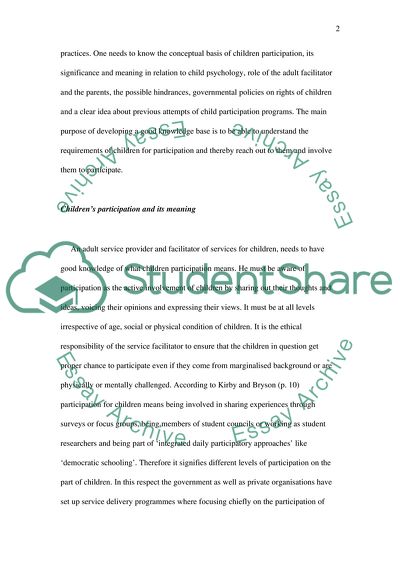Cite this document
(Aspects of Children Participation Coursework Example | Topics and Well Written Essays - 1500 words, n.d.)
Aspects of Children Participation Coursework Example | Topics and Well Written Essays - 1500 words. https://studentshare.org/education/1722333-describe-and-analyse-the-specific-skills-knowledge-and-principles-that-can-be-used-to-ensure-that-children-participate-in-the-design-delivery-and-evaluation-of-childrens-services
Aspects of Children Participation Coursework Example | Topics and Well Written Essays - 1500 words. https://studentshare.org/education/1722333-describe-and-analyse-the-specific-skills-knowledge-and-principles-that-can-be-used-to-ensure-that-children-participate-in-the-design-delivery-and-evaluation-of-childrens-services
(Aspects of Children Participation Coursework Example | Topics and Well Written Essays - 1500 Words)
Aspects of Children Participation Coursework Example | Topics and Well Written Essays - 1500 Words. https://studentshare.org/education/1722333-describe-and-analyse-the-specific-skills-knowledge-and-principles-that-can-be-used-to-ensure-that-children-participate-in-the-design-delivery-and-evaluation-of-childrens-services.
Aspects of Children Participation Coursework Example | Topics and Well Written Essays - 1500 Words. https://studentshare.org/education/1722333-describe-and-analyse-the-specific-skills-knowledge-and-principles-that-can-be-used-to-ensure-that-children-participate-in-the-design-delivery-and-evaluation-of-childrens-services.
“Aspects of Children Participation Coursework Example | Topics and Well Written Essays - 1500 Words”. https://studentshare.org/education/1722333-describe-and-analyse-the-specific-skills-knowledge-and-principles-that-can-be-used-to-ensure-that-children-participate-in-the-design-delivery-and-evaluation-of-childrens-services.


